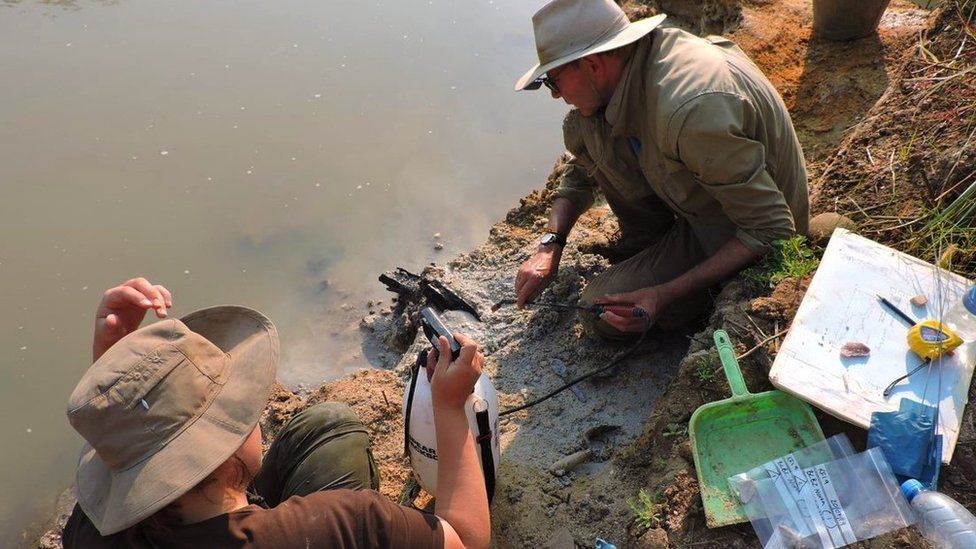ARTICLE AD BOX
 Image source, Geoff Duller
Image source, Geoff Duller
Prof Larry Barham uncovering the wooden structure on the banks of the river
By Victoria Gill
Science correspondent, BBC News
The discovery of ancient wooden logs in the banks of a river in Zambia has changed archaeologists' understanding of ancient human life.
Researchers found evidence the wood had been used to build a structure almost half a million years ago.
The findings, published in the journal Nature, suggest stone-age people built what may have been shelters.
"This find has changed how I think about our early ancestors," archaeologist Prof Larry Barham said.
The University of Liverpool scientist leads the Deep Roots of Humanity research project, which excavated and analysed the ancient timber.
Image source, Larry Barham
The discovery could transform the current belief ancient humans led simple, nomadic lives.
"They made something new, and large, from wood," Prof Barham said.
"They used their intelligence, imagination and skills to create something they'd never seen before, something that had never previously existed."
The researchers also uncovered ancient wooden tools, including digging sticks. But what excited them most were two pieces of wood found at right angles to each other.
"One is lying over the other and both pieces of wood have notches cut into them," University of Aberystwyth archaeologist Prof Geoff Duller said.
"You can clearly see those notches have been cut by stone tools.
"It makes the two logs fit together to become structural objects."
Making fire
Further analysis confirmed the logs were about 476,000 years old.
Team member Perrice Nkombwe, from the Livingstone Museum, in Zambia, said: "I was amazed to know that woodworking was such a deep-rooted tradition.
"It dawned on me that we had uncovered something extraordinary."
Until now, evidence for the human use of wood has been limited to making fire and crafting tools such as digging sticks and spears.
Luminescence dating
One of the oldest wooden discoveries was a 400,000-year-old spear in prehistoric sands at Clacton-on-Sea, Essex, in 1911.
Unless it is preserved in very specific conditions, wood simply rots away.
But in the meandering riverbanks above the Kalambo Falls, close to the Zambia-Tanzania border, it was waterlogged and essentially pickled for millennia.
The team measured the age of layers of earth in which it was buried, using luminescence dating.
Grains of rock absorb natural radioactivity from the environment over time - essentially charging up like tiny batteries, as Prof Duller put it.
And that radioactivity can be released and measured by heating up the grains and analysing the light emitted.
Image source, Michael Bayliss
Image caption,Scientists created models to show how overlapping logs could have been used
The size of the two logs, the smaller of which is about 1.5m (5ft), suggests whoever fitted them together was building something substantial.
Unlikely to have been a hut or permanent dwelling, it could have formed part of a platform for a shelter, the team says.
"It might be some sort of structure to sit beside the river and fish," Prof Duller said:.
"But it's hard to tell what sort of [complete] structure it might have been."
Image source, Larry Barham
Image caption,The ancient wood was preserved in riverbed sediments
It is also unclear what species of ancient human - or hominid - built it.
No bones have been found at this site so far.
Woodworking tradition
"It could have been Homo sapiens and we just haven't discovered fossils from that age yet," Prof Duller said.
"But it could be a different species - Homo erectus or Homo naledi - there were a number of hominid species around at that time in southern Africa."
Transported to the UK for analysis and preservation, the wooden artefacts are being stored in tanks that mimic the waterlogging that preserved them so beautifully for the last half-million years. But they will soon return to Zambia to be displayed.
"With this discovery, we hope to enrich our collection and use the finds to inform the interpretation of the woodworking tradition in Zambia," Ms Nkombwe said.
Continuing the work at the Kalambo Falls site, she added, "has the potential to deepen our knowledge of ancient woodworking techniques, craftsmanship, and human interactions with the environment".

 1 year ago
109
1 year ago
109








 English (US) ·
English (US) ·